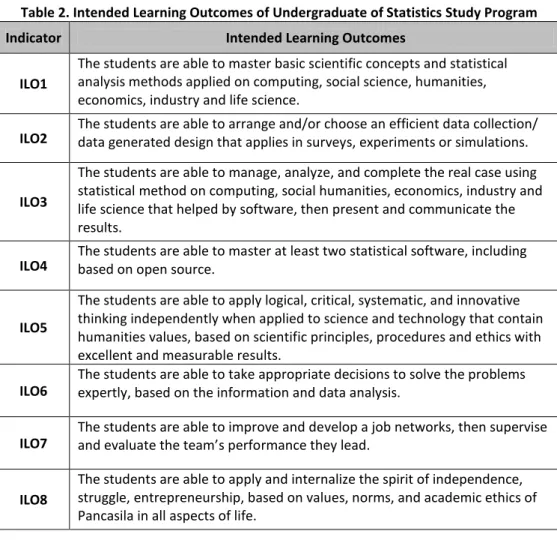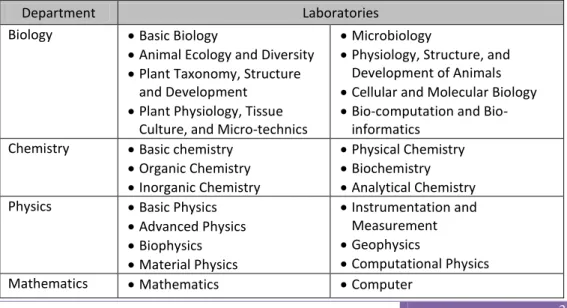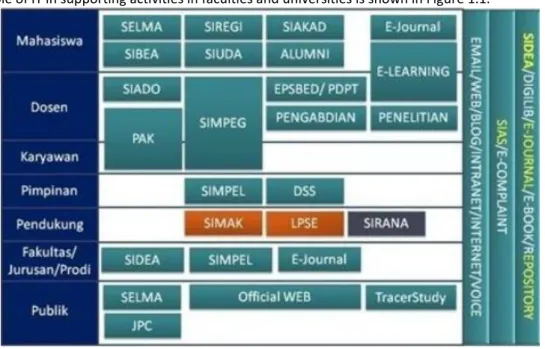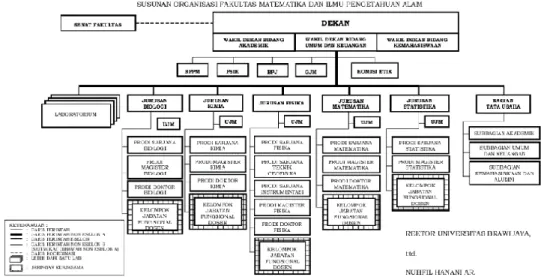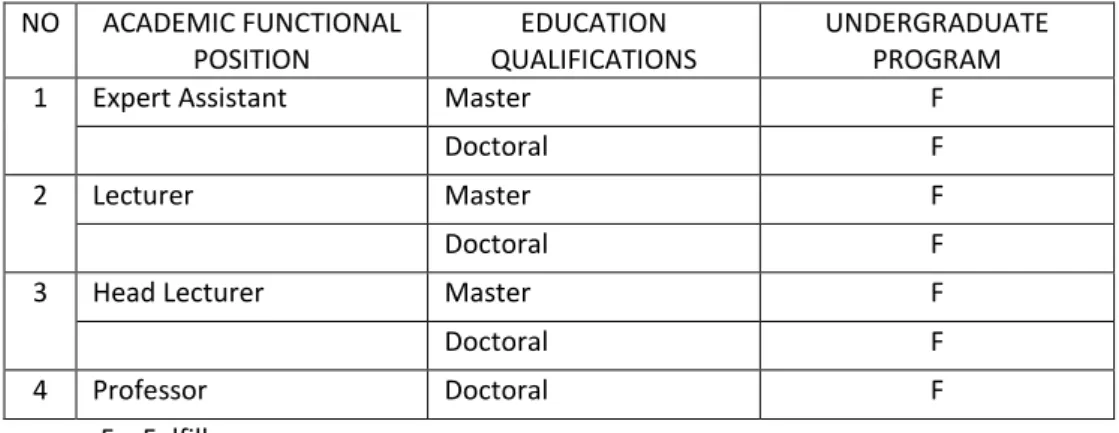INTRODUCTION
- A Brief History
- Vision and Mission
- Education Facilities
- Building
- Laboratories
- Reading Room
- Faculty Information System
- Human Resources
- Academic Community Activities
- Education and Teaching
- Research
- Community Service
- Community Development Program
- Organizational Structure
- Academic Executives
- Faculty Administrative Executives
- Faculty Administrative Executives
- Quality Assurance Group (GJM) and Quality Assurance Unit (UJM)
- Manager of Information and Public Relations Systems (PSIK)
- Journal Publishing Agency (BPJ)
- Ethics Commission
- Expertise Group
Thus, until 2013, the Faculty of Mathematics and Natural Sciences has 4 (four) departments and 16 (sixteen) study programs including undergraduate programs (7 SP) and postgraduate programs (5 SP on the Master's program and 4 SP on the Doctoral Program). 3 Book collection in the Faculty of Mathematics and Natural Sciences Reading Room (Data from January 2019).
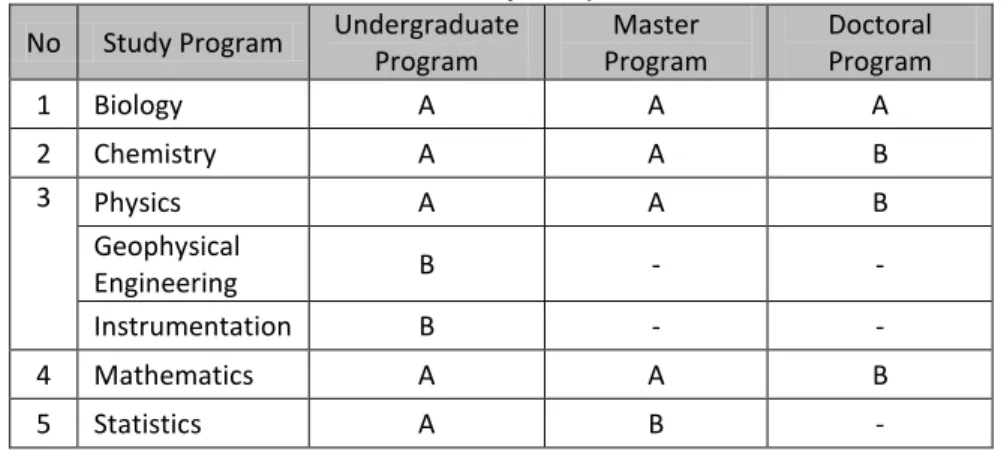
NEW STUDENT EDUCATION AND ADMISSION SYSTEM
- The Definition of Semester Credit System (SCS)
- General Purposes
- Special Purposes
- Semester Credit System (SCS)
- Learning Load and Learning Period
- Curriculum Contents
- Main Competency
- Assessment of Student Learning Outcomes
- Learning Load in a Semester
- Academic Skill Assessment
- General Requirements
- Final Score
- Remedial Exam and Special Exam
- Supplementary Exam
- Academic Sanctions
- Final Project Exam of Undergraduate Program
- Final Project Exam of Undergraduate Program
- Requirements for taking the Final Project Exam of the Undergraduate
- Procedure in Submitting Final Project Exam of Undergraduate Program
- The Examiner Assemblies for Final Project Exam of Undergraduate
- Duration of Final Project Exam of Undergraduate Program
- Assessment
- Final Project Administration Completion
- Equality of Student Written Creative Scientific Work with a Final Project 27
- Evaluation of Study Success
- Evaluation of Study Success of Undergraduate Program
- Evaluation of Student Transfer Program Success
- Short Semester Program
- Definition
- Purposes
- Implementation
- Definition
- Grades, Number of Credits and Participants
- New Student Admission System
The final project credits of the Faculty of Mathematics and Natural Sciences for undergraduate program are 6 (six) credits. The examiner compositions are determined by the Head of Department on the proposal of the First Counselor.

ACADEMIC ADMINISTRATION
- Administration Requirements for Credit System
- Implementation of Credit System Administration
- Implementation of Credit System Administration
- Student Identity Card (KTM)
- Additional Provisions regarding Student Identity Cards and Re-
- Implementation of Academic Registration
- Registration Preparation
- Filling in Study Plan Card (KRS)
- Lectures, Practicums, and Exams
- Announcement of the Final Grade
- Grade Administration
- Result Study Card (KHS)
- Storage of Student Evaluation Results
- Change in Student Status
- Academic Leave and Terminal
- Transfer to Other University / Resigned
- Dropped Out
- Die
- Termination of Universitas Brawijaya Student
- Student Transfer
- Student Transfer to Universitas Brawijaya
- Student Transfer between Faculties
- Student Transfer between Study Programs
- Student Transfer from Diploma III Program to Undergraduate Program
- Grantee
- Provisions in Paying the Tuition Fees
- New Students
- Old Students
- Graduation Requirements
- Guidance and Counseling (BK) and Academic Advisor (PA)
- Guidance and Counseling (BK)
- Academic Advisor (PA)
Guidance teachers of the department periodically report on their activities to the head of the department. After taking entrepreneurship courses, students can explain the character, role and management of the entrepreneur.
RULES AND CODE OF ETHICS OF THE BIG FAMILY OF FACULTY OF
Rules
- General Provisions
- Rights and Obligations
- Social Etiquettes and Responsibilities
To convey suggestions and opinions constructively according to applicable regulations by keeping in mind the norms of decency, politeness and in line with the personality and philosophy of the Indonesian nation. Strengthening and maintaining a sense of peers among fellows of the Big Family of Universitas Brawijaya. To be chivalrous, polite and full of responsibility towards fellow members of the Big Family of Universitas Brawijaya and the wider community.
The Faculty of Mathematics and Natural Sciences UB has a responsibility to uphold the good name of the alma mater and to realize that the university really must be a scientific society that will continuously evolve with the development of science, so that the teaching and learning process is a shared process. responsibility. Behavior that can undermine and degrade the good name of the alma mater / Great Family of Universitas Brawijaya. The large family of Universitas Brawijaya who commit offenses will be prosecuted by the Discipline Violation Commission (PANTIB) established by decree of the Rector.
The membership of PANTIB consists of academic personnel appointed by the Rector on the suggestion of the Dean of the Faculty, for a term of 2 (two) years. PANTIB submits to the Rector the results of the examination of violations of the rules and the final decision is in the hands of the Rector.
Student Code of Ethics
- General Provisions
- Purposes
- Benefits
- Standard of Behavior
- Enforcement of Code of Ethics
- Sanctions
- Other Provisions
After the course, students are able to explain and describe the functions, operations, properties of matrices and vector spaces to support the theory of the next course. After taking this course, students can design an experiment based on the objectives and characteristics of the available experimental materials. After taking this course, students are able to apply the principles of parameter estimation, derive the goodness of fit of the estimator, apply the concept of hypothesis testing, apply the concept of duality between hypothesis testing and confidence intervals, the concepts they understand in the form of individual written assignments.
After taking this course, students are able to understand and explain Pancasila in the Study of Nation History, Pancasila as the basis of the state, Pancasila as the state ideology, Pancasila as the Philosophy system, Pancasila as the Ethical System, Pancasila as the Basis. of Science Development. After taking this course, students are able to simplify the problem by modeling multiple regression, detect violated assumptions, deal with violations of assumptions underlying multiple regression analysis, the results of the modeling and analysis in writing or orally to convey in the form of written reports. Explanation of the concept of consultant science (statistics), Overview of communication techniques (general competencies), Overview of marketing statistical consulting services (general competencies), Overview of the quality of statistical consulting services (general competencies), Overview of the application of research methodologies (specific competencies ), Overview of the application of statistical data analysis methods (special competencies), Practice as a statistical consultant.
Explain the basic concepts of Biometrics theory; Design a study based on the properties of the experimental material. After taking this course, students are able to understand the quality control process and company products using statistical approach, understand the concept of the relationship between control chart, acceptance sampling and experimental design in industry and interpret the results.
DEPARTMENT OF STATISTICS
Background
Department of Statistics of Universitas Brawijaya is an organizer of academic education, namely education primarily aimed at the mastery of science and technology (Law No. 2 of 1989, CHAPTER IV, Article 11(7)). The Statistics department consists of two study programmes, namely the Bachelor's program in Statistics and the Master's program in Statistics. Department of Statistics started as a study program in the field of Statistics, under the Mathematics Study Program of Mathematics and Natural Sciences Program in 1992.
In 2016, the Department of Statistics was officially incorporated into the structure of Universitas Brawijaya based on Rector's Decree no. The Department of Statistics of Universitas Brawijaya was developed with the characteristics of courses on the development and application of statistics in the field of life sciences and economics. The Department of Statistics of Universitas Brawijaya has a vision and mission that are in line with the faculties and the university.
The Department of Statistics is encouraged to balance its position with other majors both within and outside Universitas Brawijaya. The creation of an academic atmosphere in the Department of Statistics is a must as a solid foundation to face the challenges of the rapid development of science and technology.
Vision and Mission
Purposes, Targets, and Strategic Plan of Department of Statistics
The vision and mission of the Department of Statistics are realized in accordance with the objective of UB, which is to aim to become an entrepreneurial university, to become a world-class superior university and to be able to play an active role in national development through the process of education, research and community service. Along with the vision and mission of the University, the Department of Statistics has a vision to become a center for quality education and research in statistics for the development of life sciences, economics and industry. While the missions of the Department of Statistics are: 1) Ensuring a qualitative and competitive teaching process of statistics, 2) Production of statistics graduates, who are able to develop innovation and potential as scientists, 3) Organization of statistical research activities that are competitive and have a positive impact on the development of education and science, and 4) Promotion of statistics through community, industry and education.
To achieve the ideals of its vision and mission, the Institute of Statistics is built on the principle of providing the best service to people, which is based on the new paradigm of autonomy, transparency, efficiency, productivity, accountability and quality assurance. For the Bachelor of Statistics Study Program, the number of graduates on time (four years) is at least 90%, the duration of the final project of less than six months is at least 70%, the GPA of graduates with more than 3.00 is at least 80% , and the GPA of graduates with more than 3.50 is at least 50%, the average waiting time to get the first job is less than 3 months. For the Master of Statistics Study Programme, the number of candidates on time (two years) is at least 50%, the duration of the thesis is less than six months at least 50%, the minimum GPA for candidates is 3.50 times 100% and the GPA for candidates is more than 3 .75 for a minimum of 50%, the average wait to get your first job is less than 3 months.
Increase student involvement in research and community service conducted by faculty, at least 50% of students per year. Improvement of student achievements in the academic (Scientific Writing Competition) and non-academic (Student Creativity, Sports and Art competition) national or international level at least 9 achievements per year.
Organizational Structure and Staff of Department of Statistics
Improving the quality of lecturers with a target of 75% of lecturers having PhDs and 25% of lecturers being professors. Increasing the number of publications per teacher with a goal of 1 article per teacher per year. Increasing the number of trainers participating in international seminars with a target of once per teacher per year.
Increasing the number of lecturers who participate in national seminars with the aim of once per lecturer per year. Improving the quality and quantity of international publications of lecturers with a target of 20 articles per year. Increasing the role of the Science Field Team in the teaching and learning process, scientific research and community service.
Opening of a research lab based on the Science Field Team to anticipate the development of science and the needs of students, teachers and the public using statistics. Strengthening research services for companies, other tertiary universities, BUMN and government institutions with the aim of 4 activities per year.
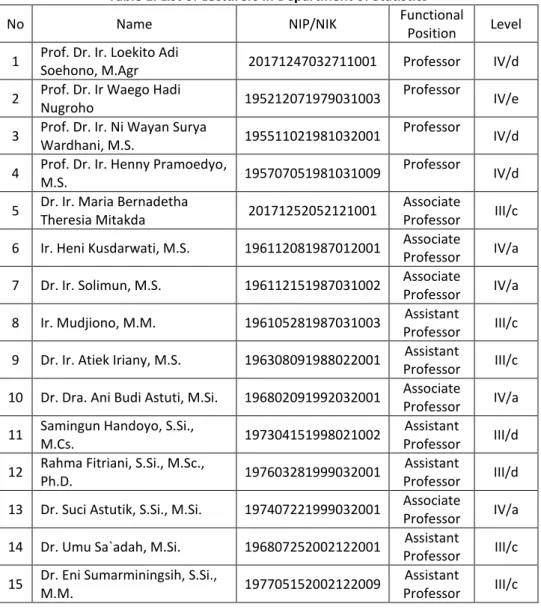
Laboratories and Its Facilities
Undergraduate Statistics Study Program
- Vision and Mission of Undergraduate Statistics Study Program
- Purposes, Targets, and Strategy of Undergraduate Statistics Study
- KKNI Based Curriculum
- Program Learning Outcomes
- The Intended Learning Outcomes of Undergraduate of Statistics Study
- Matrix of Courses and Intended Learning Outcomes of Undergraduate
- Curriculum Diagram of Undergraduate of Statistics Study Program
- Science Team (KBI)
- Long Term Research Theme
After taking this course, students will master the basic concepts of probability and be able to apply them in statistical modeling. After taking this course, students will master the concepts and be able to apply time series analysis using a time and frequency approach. After following this course, students will be able to implement abstract data types, search and sorting algorithms.
After taking this course, students are able to theoretically explain and apply Bayesian analysis to data using software, such as WinBUGS or R. After taking this course, students are able to analyze location-based data collection and to design and apply it with the help of spatial software. After taking this course, students are expected to be able to apply the fuzzy inference system for time series forecasting.
After taking this course, students will be able to understand the basic concepts of survival analysis, apply the concept of survival analysis in the natural sciences, and develop problem-solving survival analysis in the natural sciences. After taking this course, students will be able to choose and apply smoothing methods in different data patterns. After taking this course, students will be able to understand the concept of simulation, generate random numbers according to the desired distribution, simulate, run statistical models.
After completing the course, the student is able to solve the problem of simple network optimization, convey the modeling result and its analysis in writing or orally, in the form of individual or group assignments. After completing the course, the student is able to implement the method of forecasting with a time and frequency approach. After completing the course, students are able to use nonlinear analysis of time series and master the concept of its calculation and application.
